To tell your home stories inclusively with subtitles, focus on adding clear, synchronized captions that match spoken words and visuals. Use accessible formats like closed captions or sign language options, and keep text large and simple for easy reading. Incorporate descriptive sound captions for better understanding and consider multilingual subtitles to reach broader audiences. Maintaining consistency and privacy respects your viewers. If you keep exploring, you’ll discover more tips to elevate your storytelling even further.
Key Takeaways
- Use clear, simple language and adjustable subtitle sizes to accommodate diverse viewer needs and enhance understanding.
- Incorporate sign language interpretation and audio descriptions to make videos accessible to all audiences.
- Synchronize subtitles precisely with speech and visual cues for seamless storytelling and clarity.
- Maintain consistent formatting, font, and positioning to ensure professionalism and reduce viewer confusion.
- Respect privacy and copyright considerations by protecting sensitive information and avoiding unauthorized content sharing.
The Importance of Accessibility in Home Video Sharing
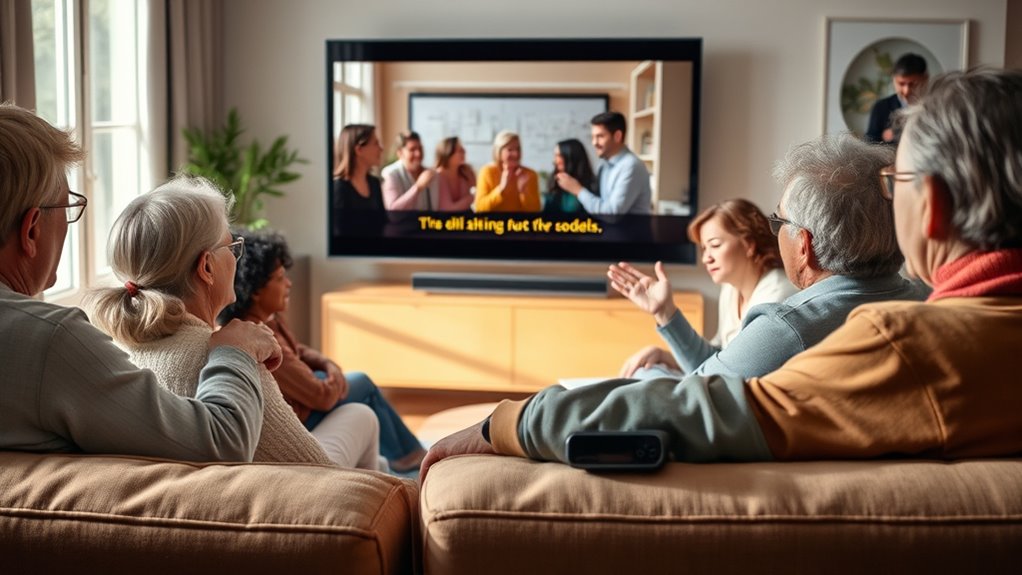
Accessibility plays a crucial role in ensuring everyone can enjoy and understand home videos. When sharing footage, you should consider privacy concerns to protect the identities and sensitive information of those featured. Respecting privacy helps prevent unintended exposure and maintains trust among viewers. Additionally, copyright considerations are essential; avoid using copyrighted music, images, or clips without permission to prevent legal issues. Making videos accessible isn’t just about adding subtitles—it’s about creating an inclusive environment where viewers of all abilities can engage with your content. Being mindful of privacy and copyright ensures your sharing remains respectful and lawful. Incorporating color accuracy and proper calibration can also enhance the visual clarity and understanding of your videos. By prioritizing accessibility, you foster a safe, inclusive space for everyone to enjoy your stories without concerns or restrictions.
Benefits of Using Subtitles for Personal Footage
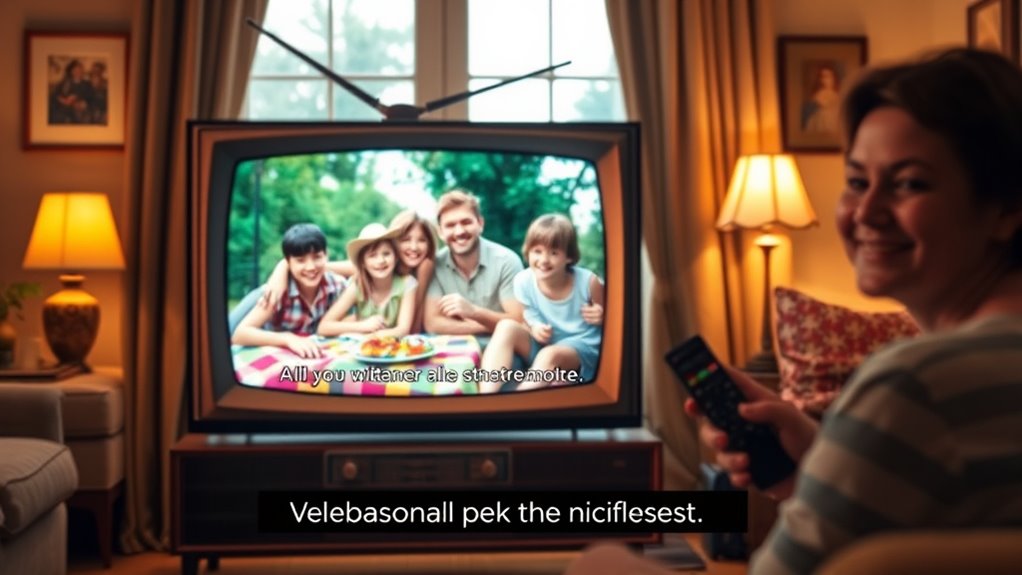
Adding subtitles to your personal footage can considerably enhance the viewing experience by making your stories clearer and more engaging. They improve understanding, especially when background noise or accents challenge voice narration. Subtitles also boost accessibility for viewers with hearing impairments, ensuring everyone can enjoy your memories. Additionally, they strengthen visual storytelling by emphasizing key moments and emotions. Here are some benefits:
- Clarify dialogue and narration for better comprehension
- Reach a wider audience, including non-native speakers
- Make videos accessible to viewers with hearing impairments
- Enhance emotional impact through synchronized text
- Support silent viewing environments without missing context
- Using arcade machines or similar hardware can inspire creative ways to display or incorporate subtitles in interactive displays.
Types of Subtitles and Their Functions
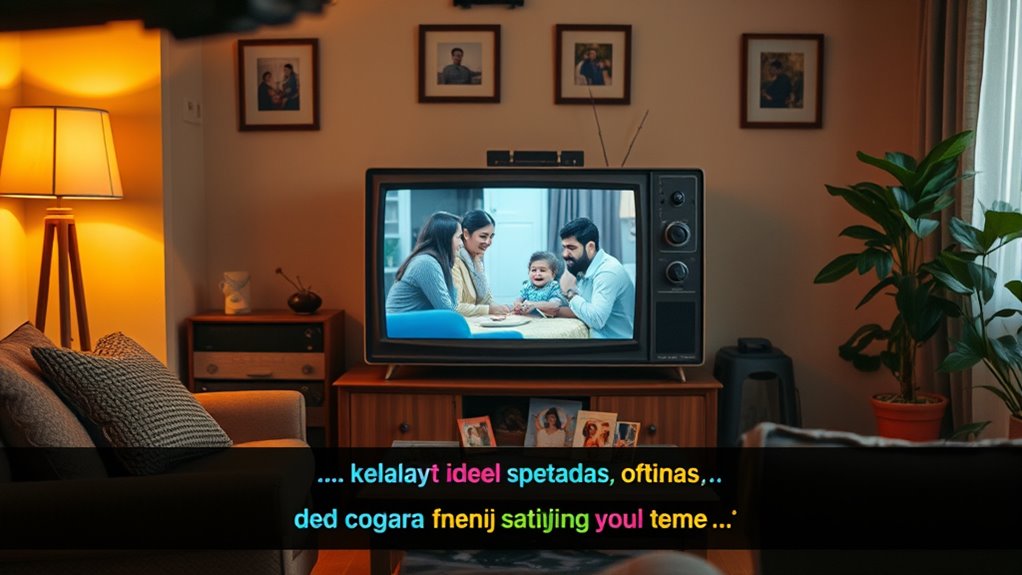
There are several types of subtitles, each serving a specific purpose to improve your video’s clarity and accessibility. These include different visual subtitle styles and caption formats that cater to various needs. For example, you can use closed captions for hearing-impaired viewers, or open captions for environments without sound. Some common types include standard subtitles, which translate dialogue, and descriptive subtitles, which include additional sound descriptions. Here’s a quick overview:
| Subtitle Type | Visual Style | Function |
|---|---|---|
| Standard Subtitles | Plain text, bottom screen | Translate dialogue |
| Closed Captions | Embeddable, toggle-able | Accessibility for hearing-impaired |
| Descriptive Captions | Text with sound info | Enhance understanding of sounds |
Tools and Software for Adding Subtitles to Videos
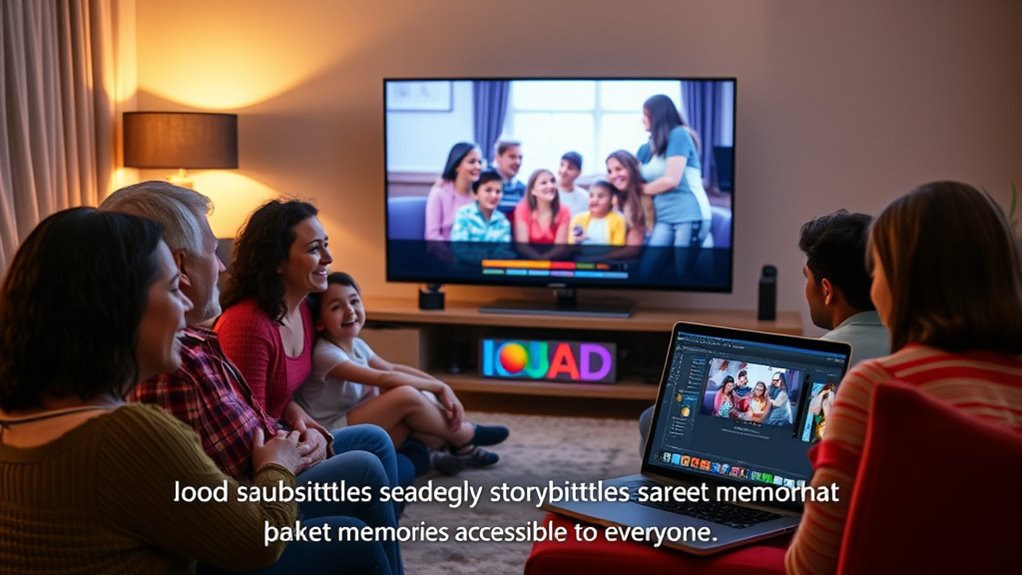
Choosing the right tools and software can streamline the process of adding subtitles to your videos, making it more efficient and accurate. Modern options often feature automatic captioning, which transcribes speech instantly, saving you time. Subtitle editing tools allow you to customize timings, fonts, and placement easily. Popular software includes:
- YouTube’s built-in captioning and editing tools
- Rev.com for professional subtitle services
- Aegisub for detailed subtitle editing
- CapCut for user-friendly editing on mobile devices
- Descript, which combines automatic captioning with editing features
These tools help you create clear, synchronized subtitles, making your videos more inclusive. Whether you prefer automated solutions or detailed manual editing, there’s software available to suit your needs and ensure your storytelling is truly accessible. Incorporating accurate captioning ensures your content meets accessibility standards and enhances viewer experience.
Tips for Creating Clear and Effective Subtitles

Ever wondered how to make your subtitles truly clear and easy to understand? The key is choosing the right font selection and subtitle positioning. Use simple, legible fonts like Arial or Helvetica, and avoid decorative styles that can distract or confuse viewers. Proper subtitle positioning ensures viewers don’t miss important visuals; place text at the bottom center, avoiding overlapping with faces or key objects. Keep your font size large enough to read comfortably on all screens. Adjust the timing so subtitles appear long enough for reading but don’t linger unnecessarily. Here’s a quick reference:
| Tip | Explanation |
|---|---|
| Font Selection | Use clear, sans-serif fonts like Arial or Helvetica. |
| Subtitle Positioning | Place subtitles at the bottom center of the frame. |
| Readability | Maintain a legible font size and appropriate timing. |
Clear subtitles enhance storytelling and accessibility.
Enhancing Emotional Impact Through Textual Narratives

To truly enhance the emotional impact of your storytelling, incorporating compelling textual narratives can make a significant difference. By applying effective narrative techniques, you create a deeper emotional resonance with your audience. Use vivid descriptions to evoke feelings, highlight personal perspectives to foster connection, and employ pacing to build anticipation. Incorporate quotes or heartfelt messages to add authenticity and intimacy. Consider the tone and style to match the mood of your video, ensuring your words complement the visuals. These strategies help transform simple captions into powerful storytelling tools that resonate emotionally. Additionally, understanding sound healing science can guide you in choosing words that reflect tranquility and healing, further enriching your narrative.
Overcoming Language Barriers With Multilingual Subtitles

Because language differences can limit your video’s reach, incorporating multilingual captions is one of the most effective ways to break down these barriers. Multilingual subtitles enable viewers from various backgrounds to understand and connect with your stories. By using language localization, you ensure the captions resonate culturally and linguistically. This approach broadens your audience and makes your content more inclusive. To implement this, consider the following ideas:
| Strategy | Benefit |
|---|---|
| Translate captions accurately | Ensures clarity across languages |
| Use culturally relevant language | Builds emotional connection |
| Offer multiple language options | Increases accessibility |
| Automate translation tools | Saves time while maintaining quality |
| Review and edit translations | Maintains integrity of message |
Multilingual captions are essential for sharing stories globally and fostering understanding beyond language barriers. Additionally, embracing creativity in your subtitle creation process can lead to more engaging and innovative ways to present multilingual content.
Best Practices for Synchronizing Subtitles With Video Content
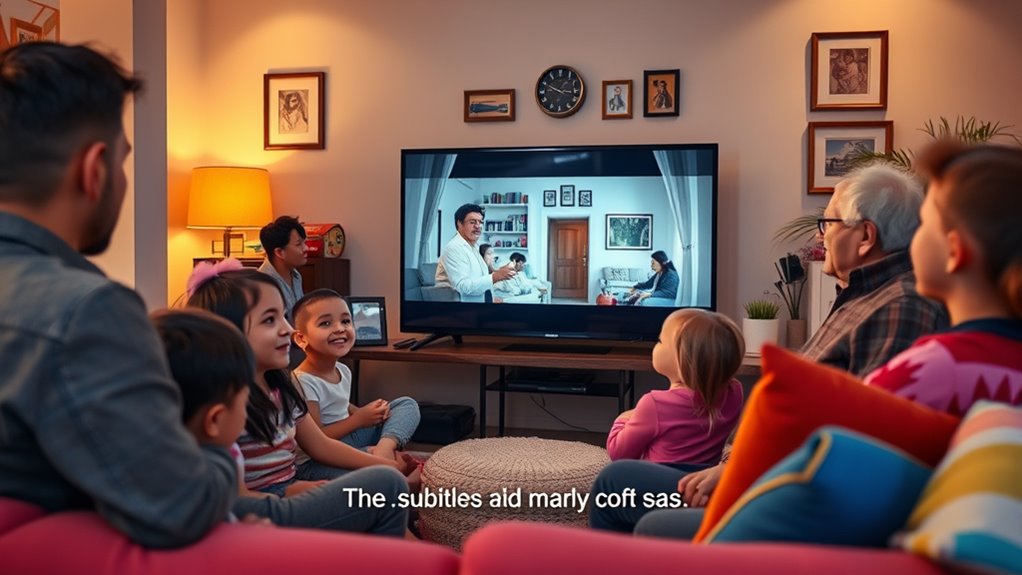
To effectively synchronize subtitles with your video, focus on precise timing alignment so viewers can follow along naturally. Make sure the text is clear and easy to read, avoiding cluttered or overly quick displays. Consistent formatting styles help maintain a professional look and improve overall viewer experience.
Accurate Timing Alignment
Ensuring that subtitles are accurately timed with the video content is essential for maintaining viewer comprehension and engagement. Proper subtitle timing, or sync accuracy, helps viewers follow the story without confusion or frustration. To achieve this, consider these best practices:
- Use precise timing tools or software for placement
- Match subtitle display duration to speech pace
- Avoid overlapping or excessive delays
- Double-check timing during editing
- Test across different devices for consistency
- Pay attention to content synchronization to ensure the flow remains natural and clear
Focusing on subtitle timing ensures your audience can effortlessly follow every word and emotion. When sync accuracy is off, viewers may miss important details or become distracted. By paying close attention to these details, you create a seamless viewing experience that keeps everyone engaged and enhances your storytelling.
Clear Text Display
Achieving clear text display is crucial for viewers to easily read and understand subtitles without distraction. To do this, ensure your subtitles are large enough and use high-contrast colors that stand out against the video background. When incorporating voice narration, synchronize the text precisely with the spoken words, so viewers can follow along effortlessly. Visual annotations, such as arrows or highlights, should complement the subtitles without cluttering the screen. Keep the text on screen long enough for comfortable reading, but avoid lingering too long, which can cause boredom. Use simple fonts and minimal styling to enhance readability. Proper timing and visual clarity help viewers focus on the story, making your subtitles a seamless part of the viewing experience. Additionally, considering environmental considerations like minimal light pollution and avoiding cluttered visuals can help improve overall clarity and viewer engagement.
Consistent Formatting Styles
Maintaining consistent formatting styles across your subtitles helps viewers follow the content smoothly and reduces confusion. When syncing subtitles with voiceover narration or background music, consistency guarantees clarity. Use uniform font size, style, and color throughout the video to avoid distraction. Keep timing aligned so viewers can read comfortably without missing key moments. Consider these best practices:
- Match subtitle duration with speech pace
- Use a clear, legible font for all text
- Synchronize subtitle placement with on-screen cues
- Maintain consistent line breaks and punctuation
- Adjust for background music volume to prevent distraction
- Be aware that store hours can vary significantly by region and day, influencing viewer expectations and planning.
Adopting these strategies helps your audience focus on the story, whether they’re following voiceover narration or background music, making your home videos more inclusive and engaging.
Ensuring Inclusivity for All Audiences

How can subtitles be crafted to truly include everyone? Start by integrating sign language interpretation options alongside text subtitles to support viewers who rely on sign language. Providing audio description services guarantees that visually impaired audiences can understand the visual content through spoken descriptions. Use clear, simple language and avoid jargon to make subtitles accessible to all literacy levels. Ensure that captions are synchronized accurately with the audio and visuals, reducing confusion. Consider offering multiple subtitle formats or adjustable sizes to accommodate different needs. By combining sign language interpretation, audio description services, and thoughtful captioning, you create an inclusive environment. Incorporating nutritional information about the content can also enhance understanding for viewers seeking additional context. This approach guarantees your home videos can be enjoyed by the broadest possible audience, fostering understanding and shared experiences.
Inspiring Examples of Subtitled Home Videos
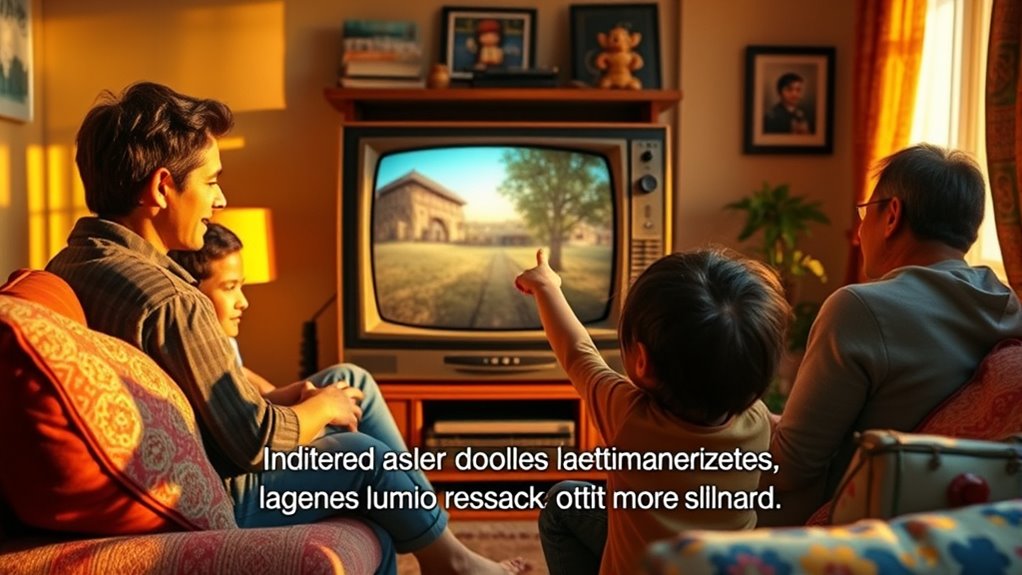
Many home videos now feature creative and heartfelt subtitles that inspire others to make their content more accessible. These examples showcase how visual storytelling can be enhanced through thoughtful subtitles, making emotional moments even more impactful. Incorporating family dynamics into subtitles can also deepen the viewer’s understanding of personal stories. Consider videos that:
- Use vibrant, animated text to highlight key emotions
- Incorporate humorous captions that add personality
- Tell multi-generational stories through synchronized subtitles
- Combine music with descriptive captions for immersive experiences
- Share cultural traditions with informative subtitles that educate and engage
These inspiring examples demonstrate how creative storytelling through subtitles transforms simple home videos into powerful narratives. By making content accessible, you can reach a broader audience and elevate your storytelling, ensuring everyone can connect with your memories and messages.
Frequently Asked Questions
How Can I Add Subtitles to Old or Damaged Home Videos?
To add subtitles to old or damaged home videos, start by improving the audio quality through audio enhancement tools, making speech clearer. Then, transcribe the dialogue accurately and synchronize the subtitles with the video using editing software. Focus on precise subtitle synchronization to match the improved audio. This process helps you preserve and share your memories more effectively, ensuring viewers understand the story despite the video’s age or damage.
Are There Budget-Friendly Options for Creating High-Quality Subtitles?
Think of creating subtitles as planting seeds of clarity. You can use cost-effective tools and DIY solutions to grow high-quality subtitles without breaking the bank. Free programs like Subtitle Edit or Aegisub let you craft accurate captions with ease. These options act as your toolkit, turning simple effort into polished results, making your home videos accessible and engaging for everyone. Budget-friendly doesn’t mean sacrificing quality—just the right approach.
How Do I Ensure Subtitles Do Not Distract From the Video Content?
To guarantee subtitles don’t distract from your video content, focus on proper subtitle timing and font readability. Keep subtitles synchronized with speech, so viewers aren’t overwhelmed or confused. Use a clear, simple font in a size that’s easy to read without blocking important visuals. Choose a subtle color that contrasts well with the background. Short, concise lines also help maintain focus on the video without overwhelming your audience.
Can Subtitles Be Customized for Different Viewing Devices and Platforms?
Yes, you can customize subtitles for different viewing devices and platforms. You just need to take into account device compatibility and platform customization options. For example, some devices support specific subtitle formats like SRT or VTT, so check what your device or platform requires. You can also adjust font size, color, and position to ensure readability across all screens. This way, your subtitles stay clear and accessible no matter how viewers watch your videos.
What Are Common Mistakes to Avoid When Creating Subtitles for Personal Videos?
Imagine you’re a time traveler, but your subtitles are a history lesson gone wrong. Avoid common mistakes like poor timing errors, which make captions hard to follow, and choosing font choices that are hard to read or distracting. Keep your subtitles clear, sync perfectly with audio, and use simple, legible fonts. Double-check your work on different devices, ensuring everyone can enjoy your videos without frustration or confusion.
Conclusion
By adding subtitles to your home videos, you make your stories accessible to everyone—regardless of hearing ability or language. Did you know that over 80% of videos on social media are watched without sound? That’s why subtitles are essential for inclusive sharing. Embrace the tools and tips available, and you’ll create more engaging, heartfelt content that reaches a wider audience, fostering connection and understanding for all viewers.











